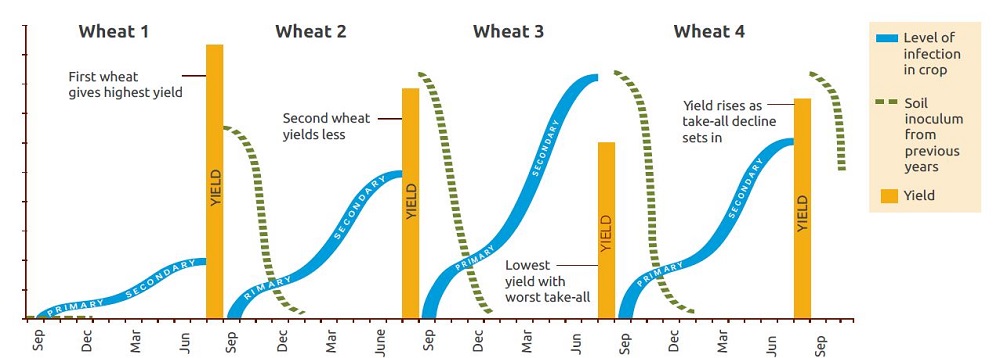- Home
- Knowledge library
- Take-all decline and cereal disease management
Take-all decline and cereal disease management
Take-all is an important soilborne disease in UK cereals. As pathogen levels increase in the soil, so do antagonistic microbial organisms – these help stabilise disease pressure and, eventually, contribute to its decline.
Cereal disease management homepage
Take-all decline occurs because microbial organisms antagonistic to the take-all fungus build up in soil, reducing the rate of secondary spread. If successive cereal crops are grown, take-all will generally build up during the second or third years. However, take-all will almost invariably decline during subsequent years, until it reaches a stable position when yields are acceptable. The yields of long-term cereals, where take-all decline is established, are never as high as those of first wheats but may allow the crop to continue to be grown economically.
Take-all decline can develop in successive crops of wheat, barley or triticale. The disease becomes most severe in winter wheat, and the consequent take-all decline is robust, conferring protection on wheat and the less susceptible cereals. However, where decline occurs under such crops, it will not protect winter wheat. Therefore, growing wheat after a barley (or triticale) crop often leads to severe take-all.
Effective take-all decline, established after a long run of susceptible crops, will not be completely lost after a one-year break or fallow. Longer or frequently repeated breaks will result in the complete loss of take-all decline.
 AHDB
AHDB
The above figure illustrates how take-all develops in successive wheat crops. It shows primary and secondary phases of infection, as well as relative yields. Crop debris, which contains inoculum, starts to decay soon after harvest. The rate of decay is an important determinant of amounts of disease in second and subsequent crops.
Wheat 1 (first wheat)
Little inoculum in soil after a break. This results in few primary infections to initiate secondary infection. Thus, there is likely to be little disease during grain filling. However, high levels of take-all inoculum may be left in the soil.
Wheat 2 (second wheat)
Residual inoculum leads to more primary and, hence, secondary infection. Second wheats are more severely diseased that first wheats and inoculum builds
Wheat 3 (third wheat)
After two susceptible wheat crops, amounts of soil inoculum are higher than in wheat 2. This ensures more primary infection, secondary infection and inoculum.
Wheat 4 (continuous wheat)
The disease becomes less severe because take-all decline reduces the rate of secondary infection. The timing of decline is variable and may not appear until the fifth crop.
Topics:
Sectors:
Tags:


.JPG)
